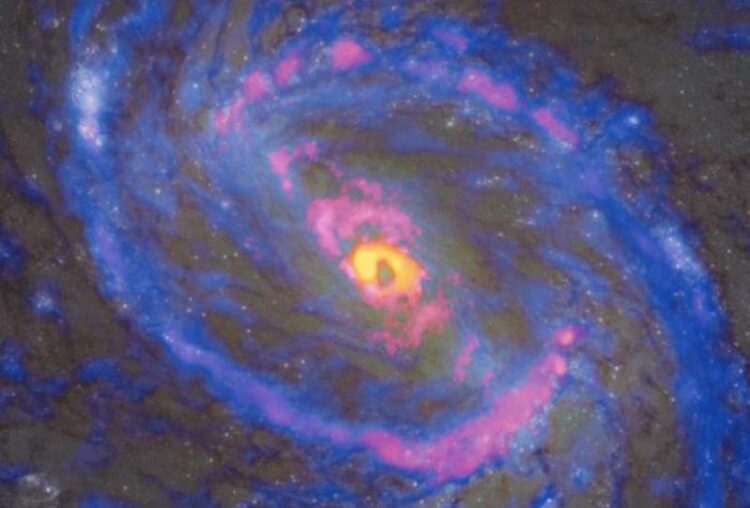Supermassive black holes alter galactic chemistry

Hydrogen cyanide isotopes (H13CN), shown in yellow, are found only around the black hole at the center. Cyanide radicals (CN), shown in red, appear not only in the center and a large-scale ring-shaped gas structure, but also along the bipolar jets extending from the center towards the northeast (upper left) and southwest (lower right). Carbon monoxide isotopes (13CO), shown in blue, avoid the central region.
Credit: ALMA (ESO/NAOJ/NRAO), NASA/ESA Hubble Space Telescope, T. Nakajima et al.
New research shows that the supermassive black hole at the center of a galaxy can have a direct impact on the chemical distribution of the host galaxy. This provides another piece of the puzzle for understanding how galaxies evolve.
It is well known that active supermassive black holes can produce major changes their host galaxies by heating up and removing the interstellar gas in the galaxy. But the compact sizes of black holes, the long distances from Earth, and obscuration by dust in the galaxies have made it difficult to measure the chemical composition distribution of the gas around an active supermassive black hole.
In this study, an international team of researchers led by Toshiki Saito at the National Astronomical Observatory of Japan and Taku Nakajima at Nagoya University used ALMA (Atacama Large Millimeter/submillimeter Array) to observe the central region of Messier 77 located 51.4 million light-years away in the direction of the constellation Cetus. Messier 77 is a relatively nearby example of a galaxy hosting an active supermassive black hole.
Thanks to ALMA’s high spatial resolution and a new machine learning analysis technique, the team was able to map the distribution of 23 molecules. This is the first survey to objectively depict the distribution of all detected molecules through unbiased observations. The results show that along the path of the bipolar jets emanating near the black hole, molecules commonly found in galaxies such as carbon monoxide (CO) seem to break down, while the concentrations of distinctive molecules such as an isomer of HCN and the cyanide radical (CN) increase. This is direct evidence that supermassive black holes affect not only the large-scale structure, but also the chemical composition of their host galaxies.
Journal: The Astrophysical Journal
DOI: 10.3847/1538-4357/ace4c7
Method of Research: Observational study
Subject of Research: Not applicable
Article Title: Molecular Abundance of the Circumnuclear Region Surrounding an Active Galactic Nucleus in NGC 1068 Based on an Imaging Line Survey in the 3 mm Band with ALMA
Article Publication Date: 14-Sep-2023
Media Contact
Naoko Inoue
NAOJ, NINS
naoko.inoue@nao.ac.jp
Original Source
https://www.nao.ac.jp/en/news/science/2023/20230915-alma.html
All latest news from the category: Physics and Astronomy
This area deals with the fundamental laws and building blocks of nature and how they interact, the properties and the behavior of matter, and research into space and time and their structures.
innovations-report provides in-depth reports and articles on subjects such as astrophysics, laser technologies, nuclear, quantum, particle and solid-state physics, nanotechnologies, planetary research and findings (Mars, Venus) and developments related to the Hubble Telescope.
Newest articles

You are What You Eat—Stanford Study Links Fiber to Anti-Cancer Gene Modulation
The Fiber Gap: A Growing Concern in American Diets Fiber is well known to be an important part of a healthy diet, yet less than 10% of Americans eat the minimum recommended…

Trust Your Gut—RNA-Protein Discovery for Better Immunity
HIRI researchers uncover control mechanisms of polysaccharide utilization in Bacteroides thetaiotaomicron. Researchers at the Helmholtz Institute for RNA-based Infection Research (HIRI) and the Julius-Maximilians-Universität (JMU) in Würzburg have identified a…

ASXL1 Mutation: The Hidden Trigger Behind Blood Cancers and Inflammation
Scientists show how a mutated gene harms red and white blood cells. LA JOLLA, CA—Scientists at La Jolla Institute for Immunology (LJI) have discovered how a mutated gene kicks off…



